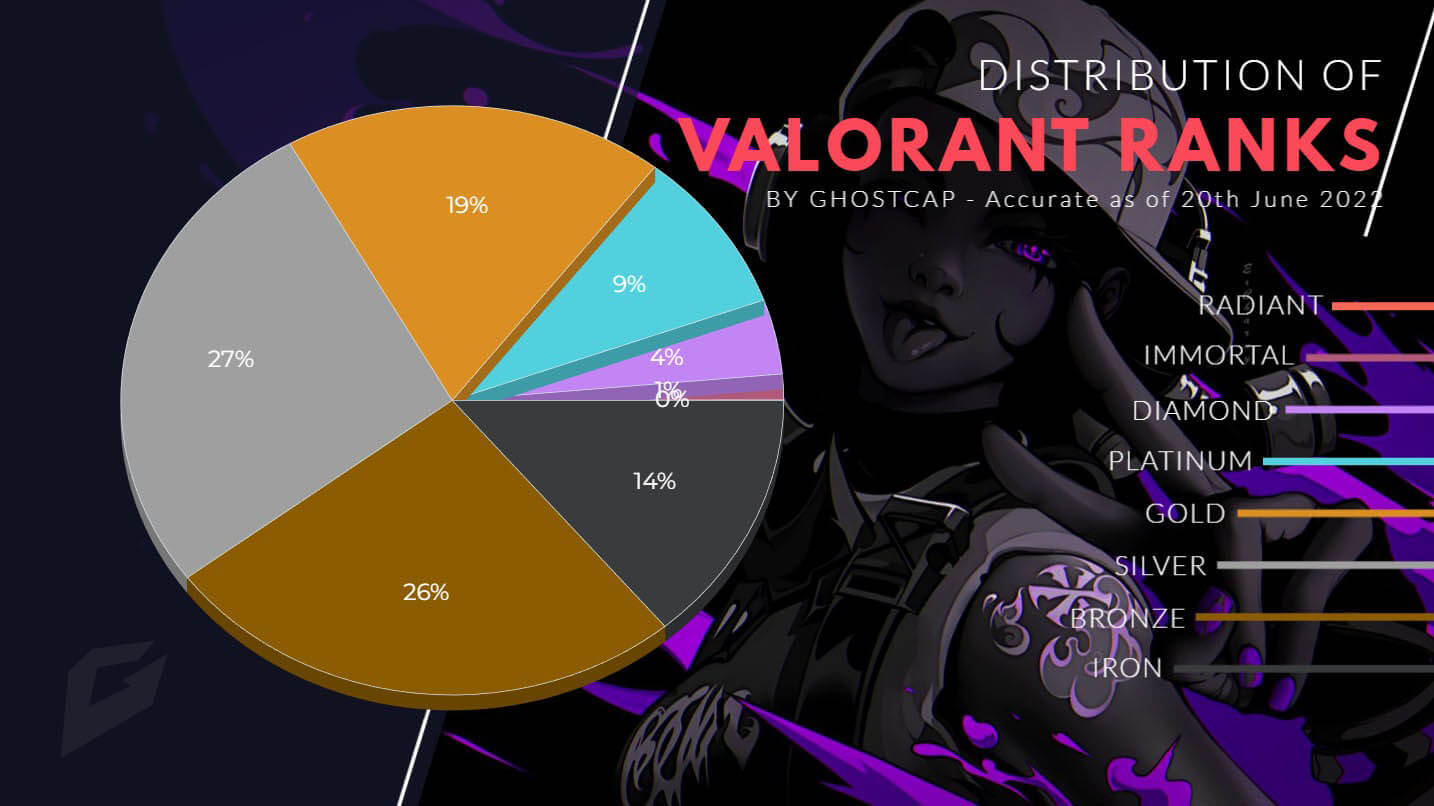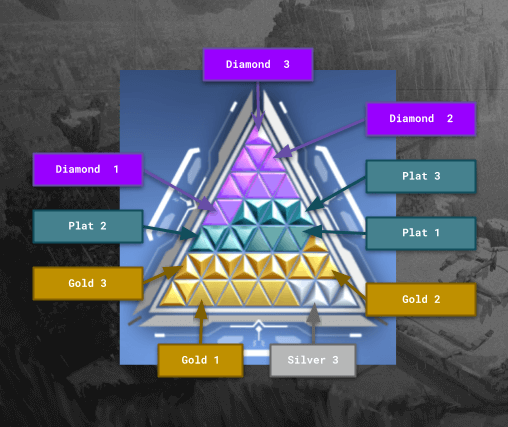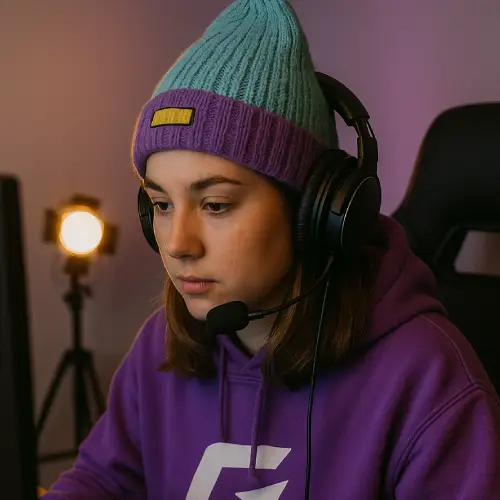So you just started playing Valorant at the lower ranks, and you suddenly got the urge to become a better player. You finally work your way up from Iron to Silver, all that hard work paid off. Then one competitive match you face an Immortal rank player, and in a flash, you get sent back to the previous rank of Iron.
Determined to improve your overall performance, you scour the internet for every guide possible to help you win matches. You then quickly realize you're actually a noob, and you need to start with the basics before you can climb the ranks. Now you're here, looking at Valorant's ranking system to see what you need to achieve to reach the top.
Valorant Ranks in Order
As of 2025, there are nine tiers in Valorant's competitive ranking system. Each tier (except Radiant) has three sub-ranks, with 1 being the lowest and 3 being the highest. Here are all the Valorant ranks from lowest to highest:
Iron
- Iron 1
- Iron 2
- Iron 3
Bronze
- Bronze 1
- Bronze 2
- Bronze 3
Silver
- Silver 1
- Silver 2
- Silver 3
Gold
- Gold 1
- Gold 2
- Gold 3
Platinum
- Platinum 1
- Platinum 2
- Platinum 3
Diamond
- Diamond 1
- Diamond 2
- Diamond 3
Ascendant
- Ascendant 1
- Ascendant 2
- Ascendant 3
Immortal
- Immortal 1
- Immortal 2
- Immortal 3
Radiant
- Radiant (no sub-ranks)
How to Unlock Valorant Ranked Mode
Before you can play Valorant's ranked mode and start climbing the competitive ladder, you need to meet specific requirements. First, you must reach account level 20 by playing unrated matches. This helps you familiarize yourself with agents, abilities, and maps.
Once you've reached level 20, you'll need to complete five placement matches in competitive mode. These matches determine your starting rank based on your performance. After placement, you can begin grinding to climb from Iron to the coveted Radiant rank.
How the Valorant Ranking System Works
Like any competitive FPS game, you have to climb the ladder and win matches to rank up. It can be exhausting and time-consuming, especially for players new to tactical shooters. Playing with a consistent team helps, as solo queue can be frustrating when trying to climb ranks.
It's also helpful to understand the community lingo, like what 'nt' means. Sometimes, you may need to surrender if a match isn't going well. The ranking system determines your tier, which affects the rewards you receive - the higher your rank, the better your rewards.
Valorant Rank Distribution

As of 2025, the Valorant rank distribution has stabilized since the introduction of the Ascendant rank. Here's the current distribution of Valorant players across all ranks, according to data from EsportsTales:
| Rank Tier | Percentage | Breakdown |
|---|---|---|
| Iron | 12.9% | Iron 1 (2.8%), Iron 2 (3.9%), Iron 3 (6.2%) |
| Bronze | 24.4% | Bronze 1 (7.1%), Bronze 2 (8.8%), Bronze 3 (8.5%) |
| Silver | 24.9% | Silver 1 (9.2%), Silver 2 (8.1%), Silver 3 (7.6%) |
| Gold | 17.3% | Gold 1 (7.2%), Gold 2 (5.5%), Gold 3 (4.6%) |
| Platinum | 10.3% | Platinum 1 (4.3%), Platinum 2 (3.2%), Platinum 3 (2.8%) |
| Diamond | 5.9% | Diamond 1 (2.4%), Diamond 2 (1.9%), Diamond 3 (1.6%) |
| Ascendant | 3.4% | Ascendant 1 (1.4%), Ascendant 2 (1.1%), Ascendant 3 (0.9%) |
| Immortal | 0.8% | Immortal 1 (0.5%), Immortal 2 (0.2%), Immortal 3 (0.1%) |
| Radiant | 0.03% | Single tier |
The majority of players remain in the Silver and Gold ranks, representing the average skill level. Only 0.03% of the player population reaches Radiant, making it one of the most exclusive ranks in competitive gaming. The addition of Ascendant has helped create better distribution between Diamond and Immortal ranks.
Valorant Act Ranks

An act is a competitive period within an episode (season) that typically lasts about 2 months. Every episode contains 3 acts. Your Act Rank measures your overall progression and is based on your highest-ranked wins, representing your proven skill level.
Your act rank badge displays small triangles representing the ranks of your wins. As you progress, lower rank wins are replaced with higher rank wins. The border surrounding the pyramid changes based on your number of competitive wins.
You can view your act rank progress in your career tab. At the end of each act, there's a soft reset requiring one placement match. At the end of each episode, you'll receive a gun buddy representing your highest achieved rank.
Matchmaking Rating (MMR) and Rank Rating (RR)
Riot uses a hidden Matchmaking Rating (MMR) system to match players of similar skill levels. Your MMR adjusts based on performance - it increases when you win and decreases when you lose. The system uses MMR to create balanced matches.
Rank Rating System
Iron to Ascendant: Players need 100 RR to advance through each sub-rank. Win matches to gain RR, lose matches to lose RR.
Immortal to Radiant: Players must reach specific regional RR thresholds to advance. These thresholds vary by region based on the competitive population.
MMR vs Current Rank
- MMR > Current Rank: Gain more RR on wins, lose less on losses
- MMR = Current Rank: Gain and lose similar RR amounts
- MMR < Current Rank: Gain less RR on wins, lose more on losses
Episode and Act Resets
New episodes require five placement matches, with Ascendant 1 being the highest possible placement. Acts 2 and 3 require one placement match each. This system ensures competitive integrity while allowing skilled players to quickly return to their appropriate ranks.
Tracking Your Progress
You can view your match history and rank progression in the career tab. This shows your KDA, win rate, and performance trends. For more detailed statistics, several third-party platforms offer enhanced tracking:
- Tracker.gg: Comprehensive stats and leaderboards
- Blitz.gg: Real-time performance analysis
- Overwolf: In-game overlay with live stats
These tools help identify areas for improvement and track your journey through the ranks.
Tips for Climbing Ranks
Improving your rank in Valorant requires dedication and smart practice. Here are essential tips to help you climb:
- Master the fundamentals: Focus on crosshair placement, movement, and ability usage
- Learn from better players: Watch pro matches and Valorant Champions Tour tournaments
- Communicate effectively: Use voice chat and callouts to coordinate with your team
- Review your gameplay: Analyze your mistakes and learn from them
- Warm up before ranked: Practice your aim in the range or deathmatch
- Stay positive: Mental attitude affects performance significantly
Frequently Asked Questions
What's the average Valorant rank?
Most players fall between Silver 1 and Gold 1, representing the median skill level.
Can you lose your rank in Valorant?
You can demote between sub-ranks and tiers based on losses. However, you cannot demote due to inactivity.
What happens if you leave a Valorant game?
Leaving results in penalties including RR loss and potential temporary bans.
How long does it take to rank up?
Ranking up depends on your win rate and performance. With a positive win rate, expect to rank up every 5-10 net wins.
Conclusion
Understanding Valorant's ranking system is crucial for competitive success. Whether you're just starting your journey or pushing for Radiant, focus on consistent improvement rather than just your rank. The distribution has evolved to create fair matches at every level, ensuring competitive integrity.
Remember, even professional players started in lower ranks. With dedication, practice, and the right mindset, you can climb the competitive ladder. Good luck on your journey to Radiant!
![All Valorant Ranks In Order [Easily Explained]](/images/valorant-ranks-valorant-ranks-ghostcap-gaming.jpg)
